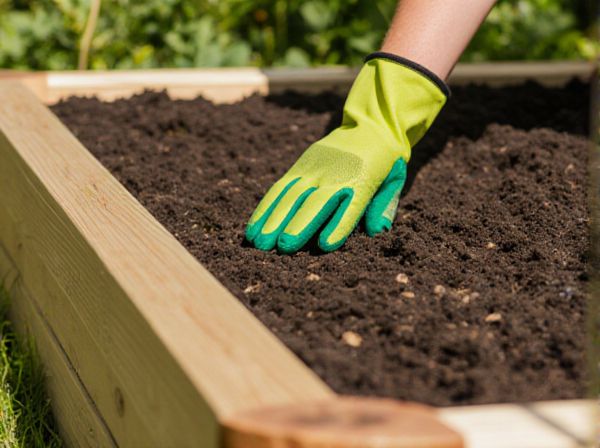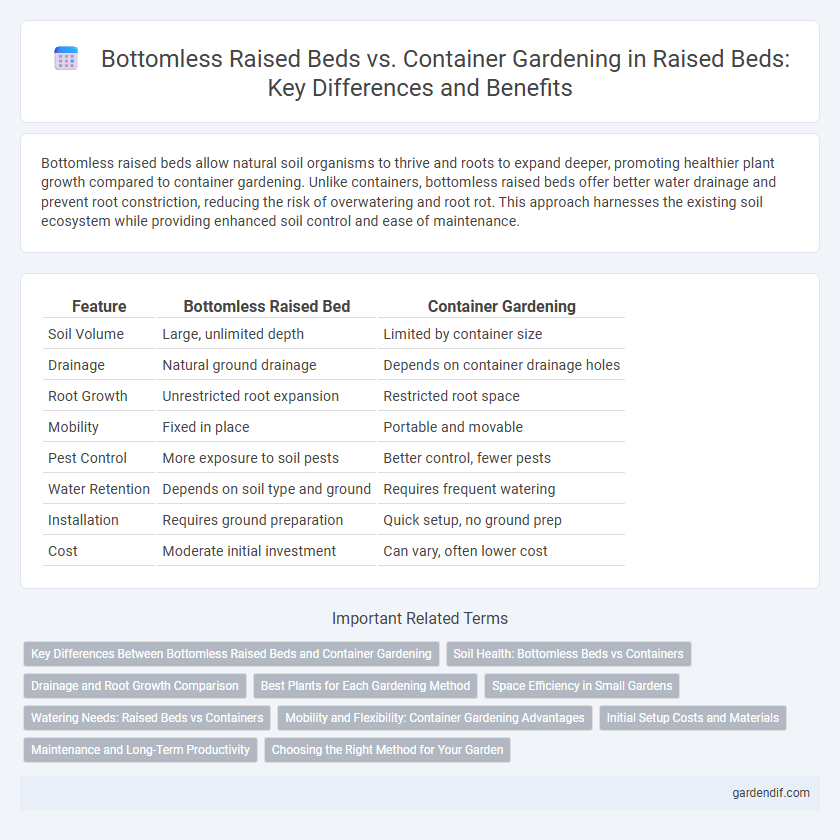
Bottomless raised bed vs Container gardening Illustration
Bottomless raised beds allow natural soil organisms to thrive and roots to expand deeper, promoting healthier plant growth compared to container gardening. Unlike containers, bottomless raised beds offer better water drainage and prevent root constriction, reducing the risk of overwatering and root rot. This approach harnesses the existing soil ecosystem while providing enhanced soil control and ease of maintenance.
Table of Comparison
| Feature | Bottomless Raised Bed | Container Gardening |
|---|---|---|
| Soil Volume | Large, unlimited depth | Limited by container size |
| Drainage | Natural ground drainage | Depends on container drainage holes |
| Root Growth | Unrestricted root expansion | Restricted root space |
| Mobility | Fixed in place | Portable and movable |
| Pest Control | More exposure to soil pests | Better control, fewer pests |
| Water Retention | Depends on soil type and ground | Requires frequent watering |
| Installation | Requires ground preparation | Quick setup, no ground prep |
| Cost | Moderate initial investment | Can vary, often lower cost |
Key Differences Between Bottomless Raised Beds and Container Gardening
Bottomless raised beds integrate directly with the soil, allowing roots to extend naturally and improving drainage and air circulation, whereas container gardening confines plant roots within limited soil volume, impacting growth potential. Bottomless raised beds offer better water retention and soil temperature regulation due to direct earth contact, while containers require more frequent watering and temperature monitoring. Choosing between the two depends on space availability, soil quality, and plant type, with bottomless beds suited for long-term, permanent gardening and containers ideal for mobility and soil control.
Soil Health: Bottomless Beds vs Containers
Bottomless raised beds promote superior soil health by allowing natural soil organisms to thrive and roots to expand into the native earth, enhancing nutrient cycling and drainage. In contrast, containers restrict root growth and can lead to quicker soil depletion and compaction, requiring more frequent soil amendments to maintain fertility. The unrestricted interaction between bottomless beds and the underground ecosystem supports long-term soil vitality better than the isolated environment of container gardening.
Drainage and Root Growth Comparison
Bottomless raised beds offer superior drainage compared to traditional container gardening, as water freely drains into the native soil, preventing waterlogging and promoting healthy root oxygenation. In contrast, containers often have limited drainage holes, which can lead to stagnant water and root rot if not managed properly. Root growth in bottomless raised beds tends to be more extensive and natural, allowing plants to access a larger soil volume and essential nutrients beyond the confined space of a container.
Best Plants for Each Gardening Method
Bottomless raised beds are ideal for deep-rooted vegetables like carrots, potatoes, and tomatoes, which benefit from unrestricted soil depth and improved drainage. Container gardening suits herbs, leafy greens, and compact plants such as basil, lettuce, and strawberries that thrive in controlled soil environments with precise moisture control. Selecting plants based on root depth and growth habits maximizes yield and plant health for each gardening method.
Space Efficiency in Small Gardens
Bottomless raised beds maximize space efficiency in small gardens by allowing roots to grow directly into the native soil, promoting healthier plant growth and better drainage without the need for large soil volumes. Container gardening, while versatile and portable, often limits root expansion due to confined space, which can restrict plant size and yield. Raised beds offer a more sustainable use of limited garden space by enhancing soil depth and nutrient availability, making them ideal for maximizing productivity in compact areas.
Watering Needs: Raised Beds vs Containers
Bottomless raised beds naturally allow excess water to drain into the soil, reducing the frequency of watering compared to containers that require more consistent moisture control to prevent drying out. Container gardens often need daily watering during hot weather because their limited soil volume retains less moisture. Raised beds offer improved water retention and aeration by allowing roots to access deeper soil moisture, making them more efficient for sustained watering needs.
Mobility and Flexibility: Container Gardening Advantages
Container gardening offers superior mobility and flexibility compared to bottomless raised beds, allowing gardeners to easily relocate plants based on sunlight, weather conditions, or aesthetic preferences. Containers come in various sizes and materials, providing adaptability for different plant types and spaces, ideal for urban or small-scale gardening. This flexibility supports seasonal planting and pest management, enhancing overall garden productivity.
Initial Setup Costs and Materials
Bottomless raised beds typically require durable materials such as treated lumber, stone, or metal and involve moderate initial setup costs due to groundwork preparation and soil amendments. Container gardening often demands purchasing pots or containers made from plastic, ceramic, or fabric, which can vary widely in price depending on size and quality but generally has lower initial setup expenses. Both methods require soil and plants, but container gardening's flexibility in material choice often makes it more budget-friendly for beginners.
Maintenance and Long-Term Productivity
Bottomless raised beds offer superior drainage and root expansion, reducing maintenance by preventing waterlogging and promoting healthier plant growth. Container gardening demands frequent watering and nutrient management due to limited soil volume, which can hinder long-term productivity. Over time, bottomless raised beds support sustainable plant development with less effort compared to the intensive upkeep of containers.
Choosing the Right Method for Your Garden
Bottomless raised beds offer improved drainage and root aeration by allowing direct soil contact, making them ideal for nutrient retention and larger plant growth compared to containers. Container gardening provides portability and better control over soil quality, suited for small spaces or urban environments. Selecting the right method depends on garden size, soil conditions, and plant types, balancing durability, maintenance, and growth needs.
Bottomless raised bed vs Container gardening Infographic

 gardendif.com
gardendif.com